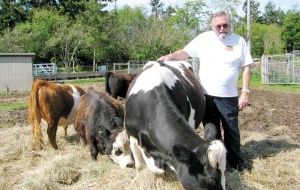MercoPress. South Atlantic News Agency
Environmentally friendly mini-cows latest trend in US farms
 Professor Richard Gradwohl and his mini cattle
Professor Richard Gradwohl and his mini cattle They have become the latest trend in United States farms and an estimated 20.000 miniature cattle, weighing less than 300 kilos, are believed to be successfully breeding and could be indicating the future for environmentally-friendly beef.
According to The Guardian, US farms are ditching Holsteins and Aberdeen Angus for their smaller counterparts. Professor Richard Gradwohl is responsible for 18 new breeds of miniature cattle on his Seattle farm, including a Miniature Panda – a fluffy eye-patched little cow just 107cm high. (His micro-mini cattle are less than 96.5cm tall – those shorter than 92cm are known as “teacup cattle”.)
“When I started frittering around with miniature cattle, everyone thought I was nuts,” he says. Since the 1940s, US farmers have been breeding cows for size, making them much larger than their British cousins. But with Gradwohl's farm being swallowed up by rising taxes, he had to give up 60 acres of land.
He discovered that it is possible to raise 10 miniature cows on five acres, rather than just two full-sized cows, meaning that land could yield up to three times as much beef – but the cows only need one third of the feed.
“These little cows were just right for me,” he says. And, given worries about cows' contribution to greenhouse gases, it takes 10 mini cows to produce the amount of methane of one full-sized cow.
Gradwohl now ships semen, embryos and cattle all over the world – except to the UK, where 1,400 farmers already breed Dexters, which are 96-111cm tall.
And the mini cows' beef tastes great. The bigger the cow, the longer the cells in the muscle are. A shorter cell means more tender beef, so smaller breeds have naturally better flavored.
Although they sound innovative, mini cows date back to the 1600s, says Gradwohl, when “British farmers developed small breeds because they only had five-acre farms”. Now, with a bit of luck, more farmers of the 1.3 billion-strong cattle worldwide might also try them out for size.




Top Comments
Disclaimer & comment rulesCommenting for this story is now closed.
If you have a Facebook account, become a fan and comment on our Facebook Page!